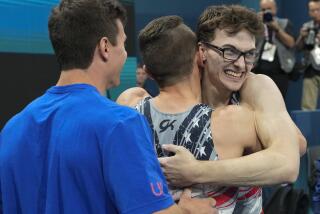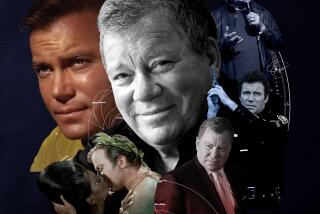He Still Has the Fighting Spirit
- Share via
Bill Shoemaker blows into a tube that makes his motorized wheelchair accelerate and steers through a tight doorway into Office 1-C, in one of the barns just behind Hollywood Park. His telephone is ringing. Not having the use of his hands, he can’t answer it.
A quadriplegic, approaching his 65th birthday, Shoemaker has spent a little more than five years in the chair. Once he was the world’s greatest rider of horses. Now he trains them. There are also other things he can now do.
“I can do this,” he says.
He wiggles his left shoulder.
“And this,” he says.
He jiggles his right hand.
Some movement is better than no movement, even if it is only a flinch. At home is a bicycle, and when a switch is flipped, Shoemaker’s legs automatically turn with the pedals. He can turn on the television. He can turn on the lights. He can function at home by himself.
The chair has five switches marked standby, indoor, outdoor, auxiliary 1 and auxiliary 2, choices made with the warmth from a finger, speed controlled by how hard Shoemaker puffs into the pipe. He remembers first using such a chair at the Craig institute in Englewood, Colo., where he convalesced from the accident. He remembers “putting a lot of holes in the wall,” running into it.
“Looks like you’ve mastered it,” a visitor says.
The chair is turned so Shoemaker can face out, toward the horses in their stalls.
“I’ll get up,” he says.
Get up?
“I’m going to get up out of this thing one of these days. I’ll keep trying, as long as it takes. They’ve made a lot of progress in spinal-cord injuries. You never know what amazing things they could still come up with.”
The chair itself, for instance.
Shoe is getting a modified one soon, with some new innovations. For one thing, he says, “I’ll be able to answer the phone. They’ve designed something where I can blow into the tube and make the phone respond. I’ll be able to use a computer, the same way.”
When his office phone rings again, it has to be answered the old-fashioned way.
Removing his lips from the pipe, Shoemaker calls over to a man standing nearby, in a sing-song voice: “Telefono, por favor.”
With more privacy, the man could press the speaker-phone button. Instead, he places a headset to Shoe’s ear.
It’s his daughter calling. Amanda Shoemaker is a few days shy of her 16th birthday. She chose to keep living with her father in their Arcadia home. Shoemaker’s wife has left him. A little more than five years have passed since the single-car accident that paralyzed Shoemaker from the neck down, April 8, 1991. Amanda is a big help at home, even helps out with the horses he trains.
Shoe says into the phone, “Straighten up your room.”
The man takes back the headset and hangs up.
“Your daughter was only 10 when this happened to you?” Shoemaker’s visitor asks.
“I guess that’s right,” he says.
“Must have shaken her up.”
“No, she was really strong, right from the start. She would have made a great nurse. I think she’ll make a great anything.”
Shoemaker was 49 when his daughter was born. He was well on his way to an almost mythic career, with 8,833 victories.
One of the 1,009 stakes races he won--the 1,000th, in fact--was the Premiere Handicap, the oldest stakes race at Hollywood Park, begun in 1938. Shoe won aboard a horse named Peace. After the jockey’s final race, Feb. 3, 1990, the track renamed the stake in his honor, as the Shoemaker Breeders’ Cup Mile. The richest turf race in North America outside of the actual Breeders’ Cup Mile, it will be run again Sunday.
Shoe will attend. He has his eye on Laffit Pincay, who with 8,435 victories is coming after his all-time record. Pincay is only 398 shy.
Keeping an eye on his idol in return, Pincay says of Shoemaker, “He still watches the races, jokes around with the guys, he’s like his old self. He doesn’t talk as much as he used to, but otherwise it’s like he’s the same man. You have to admire what he’s doing. How many people would still be this strong, after what he’s been through?”
Shoe says, “The day Laffit breaks my record, I’ll be the first one out there. I wish he’d do it on one of my horses.”
He plans to be there.
“It’s good, horse racing. It’s a nice life,” he says. “I’ll go as far as I can go. You have to have something to do.”
A visitor asks, “Have you spoken with [actor] Christopher Reeve?”
“No, but I want to,” Shoemaker says. “We’re in the same boat. I was at a fund-raiser with him, but he’d been flying all night and I didn’t want to bother him. He’s got a lot of spirit, doesn’t he?”
“Both of you do.”
Shoemaker blinks and says, “I didn’t at first. I never thought I’d end up like this. In the hospital in Colorado after the accident, I couldn’t think so straight. I had a halo on. I had a machine that let me breathe, a respirator, that I had to wean myself off. First I breathed on my own for five minutes. Then 10. Then 30, 45, then an hour, two hours, then 24. Then I kicked that machine out the door.”
Overcoming hardship is something Shoe has done before. He weighed two pounds at birth. Now he’s two months shy of his 65th birthday, this 4-foot-11, 98-pound man, and still overcoming. Two live-in assistants, Alvin and Harry, aid him at home in four-day shifts. Paddy Gallagher assists him training the horses. A ghostwriter came to the house with a tape recorder, to collaborate with Shoe on three racetrack mystery novels.
He has done all that. He says he will do one thing more.
“You will see me get out of this chair,” Bill Shoemaker says.


